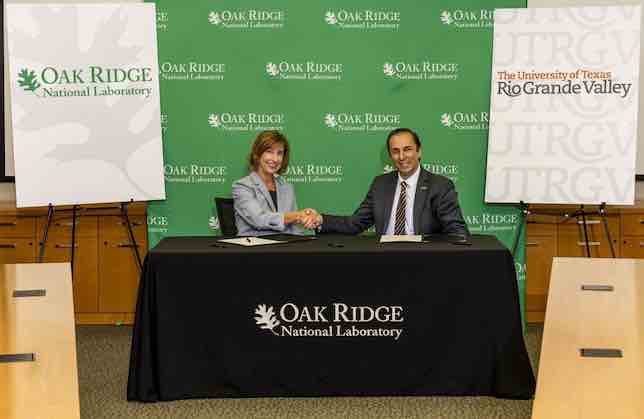UTRGV and ORNL: Boosting Research While Building a STEM Talent Pipeline
A Q&A with Can Saygin
This fall the University of Texas Rio Grande Valley signed a memo of understanding with Oak Ridge National Laboratory to strengthen their research collaborations and establish a program for undergraduate research and education. Here, CT asks Can (John) Saygin, the senior vice president for research and dean of the graduate college at UTRGV, how the MOU will be carried out and what the impacts and advantages might be, for students, for research collaborations between ORNL and UTRGV, for graduate and undergraduate research programs at UTRGV, and ultimately for the nation's STEM pipeline.

UTRGV’s Can Saygin and ORNL Deputy for Science and Technology Susan Hubbard at the MOU signing. (Photo credit: Carlos Jones/ORNL, U.S. Dept. of Energy)
Mary Grush: UTRGV is a relatively new university. Is it emerging as a research university?
Can Saygin: In 2015, UTRGV enrolled its first class of students — that was just eight years ago. But while UTRGV is a new university, it really has many years of history and experience behind it, as it comes from the merger of two legacy institutions in Texas. For its first eight years, its focus was on student success. But now, it's time to bring in the other layers that a public institution would have — including, and perhaps for us, especially research. And of course, research not only involves and benefits faculty, but when properly guided, research programs can contribute quite substantially to student success.
Grush: What is your role in guiding and establishing UTRGV as a research institution?
Saygin: I was hired in August 2022 as the senior vice president for research and dean of the graduate college. The mission that I have in front of me is to add strong research performance to UTRGV's portfolio.
We have 32,000 students — about 4,000 of those are graduate students, of which about 500 are doctoral students. Given this student population distribution, along with the range of disciplines that we have at UTRGV, we are in a very good position to enhance our research profile.
Grush: How do efforts like this recent MOU help?
Saygin: You can't be successful at research in a vacuum. You have to get out and develop partnerships, with companies, with economic development associations, and most importantly, with other institutions and national-level labs.
You can't be successful at research in a vacuum. You have to get out and develop partnerships.
Grush: The MOU with ORNL emphasizes opportunities for undergraduate research and education. Do you also have a focus on building graduate research collaborations?
Saygin: Yes, we do have a focus on graduate students, and faculty as well. The important thing is to build UTRGV's research capability and capacity overall, with the intent of becoming a Tier-1 research university within the next few years.
Grush: What else is important to know about the MOU?
Saygin: Looking at the specifics of the MOU, we decided that ORNL and UTRGV would work together on a program that would provide our students with STEM-related research and education opportunities. It started with questions about how you bring students into real-life research laboratories, and also bring them together with people from outside the UTRGV campus.
Grush: Does the program for undergraduate research and education created by this MOU ultimately open up a pathway for your students to prepare for STEM careers at the Department of Energy or with its partners, contractors, or labs?
Saygin: Yes, the program's impact is to benefit our students with real-world experiences that contribute to the nation's STEM pipeline and to student career paths. If you think about the student/career lifecycle, when students launch their careers, on-the-job learning has to happen really quickly. So, the real-life experience we can provide that prepares students for their careers is a priority. There is a need at the DOE level as well as at the ORNL level to strengthen the STEM pipeline, so that is our goal.